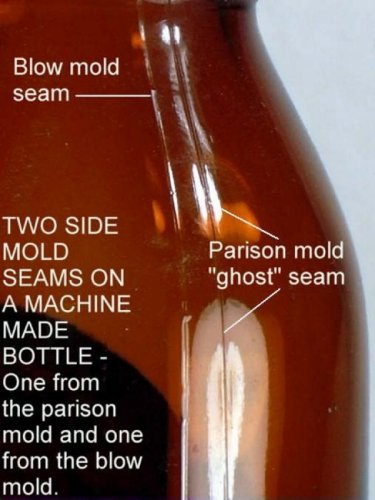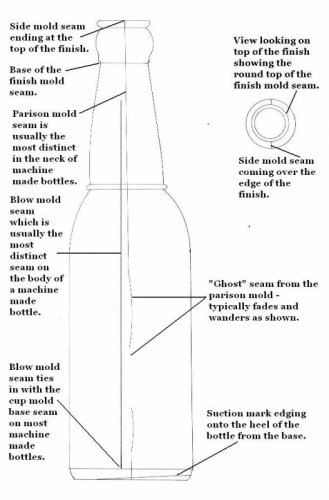surfaceone
Well-Known Member
- Joined
- Dec 9, 2008
- Messages
- 11,161
- Reaction score
- 24
- Points
- 0
Could anyone describe the "blank seam" as shown in surfaceone's illustration? Is this the wavy line that is sometimes seen which is more concave than convex? And its purpose?
Hey Jordan,
Good question, sir. The best that I can come up with is Thanks to Bill Lindsey:
"Parison mold - Also known as the blank mold, a block mold (on a press-and-blow machine), or on an Owens Automatic Bottle Machine it is sometimes called a measuring mold (Tooley 1953; World Book Encyclopedia 1958; Miller & Morin 2004)). Sometimes spelled "paraison" (Hunter 1950). This is the preliminary bottle forming mold on all automatic bottle machines which transforms a gob of glass into a preliminary bottle shape with a fully formed finish (lip) and a partially formed body. The parison mold on a blow-and-blow machine was made of two or more parts (not including the neck-ring mold) This formative bottle is then automatically transferred to a blow mold for final expansion to shape of the finished product. On the Owens machines the parison mold was apparently sized to measure the glass being sucked out of the glass pot below, thus the term measuring mold. Parison molds were unnecessary with mouth-blown bottles were only one mold was used. See the Glassmaking & Glassmakers page for more information. The blank (parison) mold concept was the revolutionary invention (patented in 1882) of Philip Arbogast of Philadelphia, PA. although the implementation of the blank mold - which forms the "finish" of the bottle - was not realized until the 1890s with the first semi-automatic machines (Howard 1950).
Parison mold seams - The mold seams that are formed on the surface of the bottle by the mold part interfaces (joints) of a semi or fully automatic machines parison mold. These can include the ghost seams on the sides and a suction scar like mark on the base of machine-made bottles."
I hope this addresses your question, Jordan...
There's a Coca-Cola hobbleskirt specific part chart On This Page.





